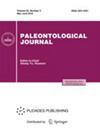第 4 章早前震旦纪风化壳
IF 0.6
4区 地球科学
Q4 PALEONTOLOGY
引用次数: 0
摘要
摘要 在前寒武纪早期,微生物、细菌,可能还有蓝藻,甚至单细胞真核生物伴随着风化壳的形成,也就是说,风化壳最初是在细菌的参与下形成的。在古风化壳中发现微生物化石非常重要,因为这表明在如此遥远的年代,陆地上已经有人居住。现代细菌古生物学研究改变了我们对地球生命进化最初阶段的认识。本文章由计算机程序翻译,如有差异,请以英文原文为准。
Chapter 4. Early Pecambrian Weathering Crusts
Abstract
In the early Precambrian, microorganisms, bacteria, possibly cyanobacteria, and even unicellular eukaryotes accompanied the formation of weathering crusts, i.e., the crusts were initially formed with the participation of bacteria. Findings of fossil microorganisms in ancient weathering crusts are important because they suggest that the land was already inhabited at such a distant time. Modern bacterial-paleontological research has changed our understanding of the earliest stages of the evolution of life on Earth.
求助全文
通过发布文献求助,成功后即可免费获取论文全文。
去求助
来源期刊

Paleontological Journal
地学-古生物学
CiteScore
1.20
自引率
33.30%
发文量
70
审稿时长
6-12 weeks
期刊介绍:
Paleontological Journal (Paleontologicheskii zhurnal) is the principal Russian periodical in paleontology. The journal publishes original work on the anatomy, morphology, and taxonomy of fossil organisms, as well as their distribution, ecology, and origin. It also publishes studies on the evolution of organisms, ecosystems, and the biosphere and provides invaluable information on global biostratigraphy with an emphasis on Eastern Europe and Asia.
 求助内容:
求助内容: 应助结果提醒方式:
应助结果提醒方式:


